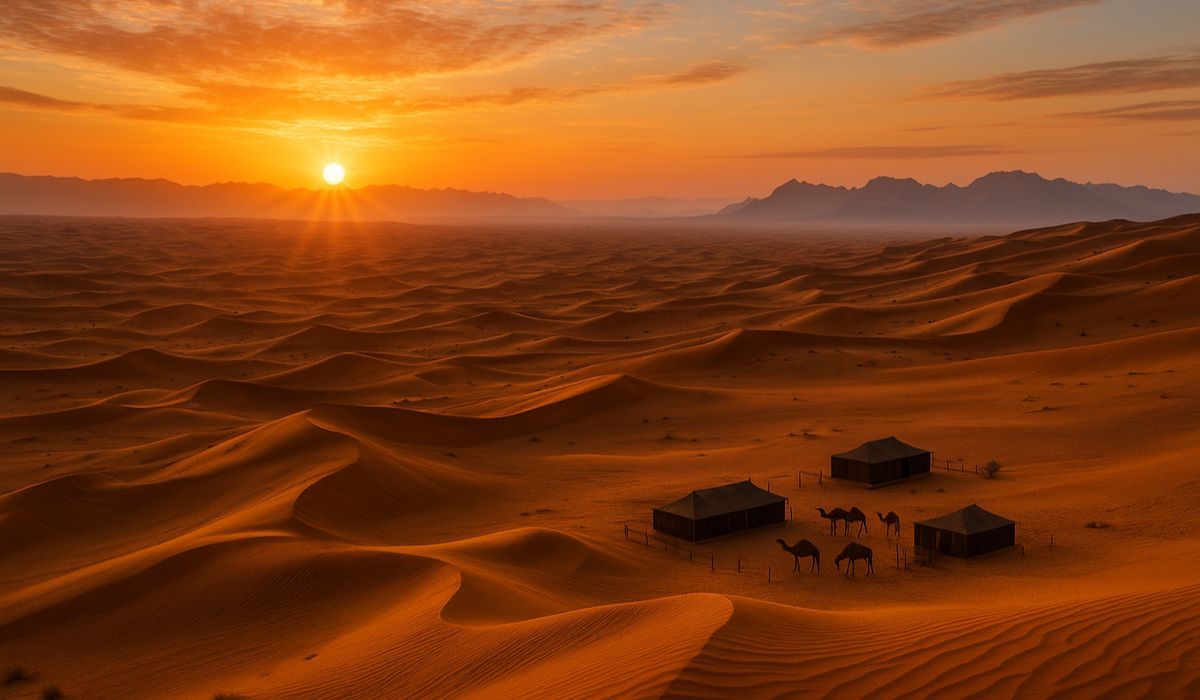Oman Travel Guide: Oman stands as the Middle East’s best-kept secret, a sultanate that preserves authentic Arabian culture while offering some of the region’s most spectacular and diverse landscapes. This peaceful nation on the Arabian Peninsula combines dramatic desert dunes, rugged mountains, pristine coastlines, and ancient forts, creating genuine adventures without the crowds found in neighbouring destinations.
Oman Travel Guide
Oman Travel Guide: Oman offers the most authentic Arabian experience available today, where traditional culture remains largely unchanged despite modern development. The country’s deliberate approach to tourism development means visitors encounter genuine local hospitality, unspoiled landscapes, and cultural traditions that have survived centuries.
The sultanate’s incredible geographical diversity allows travellers to experience multiple environments within a single trip – from the dramatic Empty Quarter desert to snow-capped mountains, from turquoise wadis (oases) to pristine beaches where sea turtles nest under starlit skies.
Omani people’s legendary hospitality, rooted in Bedouin traditions of welcoming strangers, creates meaningful cultural exchanges that transform travel into profound personal experiences. The country’s safety, political stability, and English-speaking tourism infrastructure ensure comfortable exploration of even remote areas.
Adventure seekers particularly love Oman because it offers genuine wilderness experiences, challenging hikes, and cultural immersion opportunities that have become rare in our increasingly connected world.
Dramatic Desert Landscapes
Wahiba Sands Desert
Oman Travel Guide: Wahiba Sands (Sharqiya Sands) represents one of Arabia’s most accessible and spectacular desert experiences, featuring rolling red dunes that stretch endlessly toward the horizon. Traditional Bedouin families still live in this desert, offering authentic cultural encounters and desert survival knowledge passed down through generations.
Desert camps provide overnight experiences with camel trekking, sandboarding, stargazing sessions, and traditional Omani meals cooked over open fires. The silence and vastness of this desert create meditative experiences impossible to find in urban environments.
Empty Quarter Adventures
Oman Travel Guide: The Rub al Khali (Empty Quarter) offers the ultimate desert adventure for experienced travellers seeking one of Earth’s most challenging environments. This vast desert, shared with Saudi Arabia, the UAE, and Yemen, features some of the world’s largest dunes and most extreme desert conditions.
Guided expeditions provide safe access to this legendary desert, where Lawrence of Arabia and other explorers tested themselves against nature’s harshest conditions.
Mountain Villages and Wadis
Jebel Akhdar Green Mountain
Oman Travel Guide: Jebel Akhdar, part of the Al Hajar mountain range, provides cool relief from desert heat while showcasing traditional terrace farming that has sustained mountain communities for centuries. The area’s rose gardens, pomegranate orchards, and walnut groves create unexpected alpine experiences in the Arabian Peninsula.
Traditional villages like Al Ayn and Al Aqr preserve ancient architecture and farming techniques, while hiking trails lead to spectacular viewpoints and abandoned settlements that tell stories of Oman’s mountain heritage.
Wadi Swimming and Natural Pools
Oman Travel Guide: Oman’s wadis (valleys) create natural swimming pools and oases that provide refreshing escapes into stunning natural environments. Wadi Shab features turquoise pools, hidden caves, and dramatic rocky landscapes accessible through adventurous hikes and swimming.
Wadi Bani Khalid offers easier access to crystal-clear pools surrounded by date palms, while Wadi Ghul (Grand Canyon of Oman) provides dramatic hiking with spectacular geological formations.
Ancient Forts and Historical Sites
Nizwa Fort and Souq
Oman Travel Guide: Nizwa, Oman’s former capital, centres around a massive 17th-century fort with innovative defensive features and panoramic views of the surrounding oasis. The adjacent traditional souq comes alive during Friday goat markets, silversmith demonstrations, and frankincense trading that continues ancient commercial traditions.
The fort’s museum explains Omani history, traditional crafts, and the strategic importance of controlling mountain passes and desert trade routes.
Bahla Fort and Ancient Oasis
Oman Travel Guide: Bahla Fort, a UNESCO World Heritage site, represents one of Oman’s oldest and largest fort complexes, built between the 12th and 15th centuries. The surrounding oasis, with its ancient aflaj (irrigation system), demonstrates sustainable desert agriculture practised for over 1,500 years.
Traditional pottery workshops in Bahla village continue crafts mentioned in ancient texts, while the nearby ruins of ancient settlements provide insights into pre-Islamic Arabian civilisations.
Pristine Coastlines and Marine Life
Muscat Coastal Beauty
Oman Travel Guide: Muscat combines dramatic mountains meeting pristine beaches with sophisticated urban amenities. The Sultan Qaboos Grand Mosque showcases contemporary Islamic architecture, while the historic Mutrah Souq offers traditional shopping experiences alongside the scenic Corniche.
Luxury resorts along Muscat’s coastline provide world-class accommodations with private beaches, while traditional dhow cruises offer sunset sailing experiences along the rugged Omani coast.
Ras al Jinz Turtle Reserve
Oman Travel Guide: Ras al Jinz protects one of the Indian Ocean’s most important sea turtle nesting sites, where green turtles come ashore year-round to lay eggs. Guided nighttime tours provide opportunities to witness these ancient marine creatures in their natural habitat without disturbing their nesting behaviours.
The reserve’s visitor centre educates about marine conservation while providing comfortable accommodations for wildlife enthusiasts seeking authentic nature experiences.
Authentic Omani Culture and Traditions
Frankincense Heritage
Oman Travel Guide: Oman’s frankincense heritage connects the country to ancient trade routes that brought wealth and cultural exchange for over 3,000 years. The Frankincense Trail UNESCO sites in the Dhofar region include archaeological ruins, ancient ports, and frankincense trees that still produce the precious resin.
Traditional frankincense burning ceremonies in homes and mosques continue practices that made Oman famous throughout the ancient world.
Traditional Crafts and Arts
Oman Travel Guide: Omani artisans maintain traditional crafts, including silver jewellery making, hand-woven textiles, pottery, and khanjars (traditional daggers) that represent the highest levels of Arabian craftsmanship. Workshops and markets allow visitors to observe these skills and purchase authentic pieces directly from master craftsmen.
Delicious Omani Cuisine
Omani cuisine reflects the country’s maritime heritage, desert traditions, and historical trade connections with India, Persia, and East Africa. Traditional dishes emphasise fresh seafood, rice, dates, and aromatic spices that create unique flavour profiles.
Traditional Specialities:
- Shuwa: Ceremonial roasted lamb cooked underground for special occasions
- Majboos: Spiced rice with meat or fish, similar to biryani
- Halwa: Sweet confection flavoured with rosewater and cardamom
- Fresh Dates: Multiple varieties grown in Omani oases
- Omani Coffee: Traditional preparation with cardamom and rosewater
Practical Travel Information
Best Time to Visit: October to March offers pleasant temperatures perfect for desert and mountain exploration. April to September brings extreme heat but lower prices and fewer crowds.
Budget: Oman offers excellent value with mid-range accommodations averaging $60-150 per night and traditional restaurants serving meals for $8-20 per person. Desert camps and mountain lodges provide unique experiences at reasonable prices.
Transportation: Rental cars provide the best way to explore Oman’s diverse landscapes, with excellent roads connecting major attractions. 4WD vehicles are necessary for desert and mountain adventures.
Currency: Omani Rial (OMR), one of the world’s strongest currencies. Credit cards are accepted in major establishments.
Essential Travel Tips
Respect Islamic customs by dressing modestly, especially when visiting mosques and traditional communities. Oman’s conservative culture appreciates visitors who show cultural sensitivity.
Plan desert and mountain activities during cooler parts of the day. Early morning and evening provide the best conditions for outdoor adventures and photography.
Carry plenty of water during desert and mountain excursions. Oman’s dry climate and high altitudes can cause rapid dehydration.
Learn basic Arabic greetings like “As-salamu alaykum” (peace be upon you) to enhance cultural connections with local communities who appreciate visitors’ efforts to engage respectfully.
Oman delivers authentic Arabian adventures where dramatic landscapes, genuine culture, and warm hospitality create transformative travel experiences in one of the Middle East’s most welcoming and unspoiled destinations.


